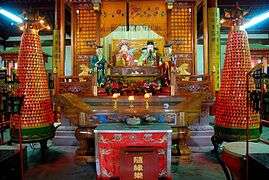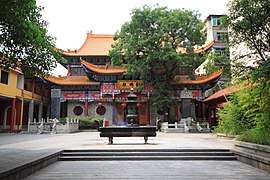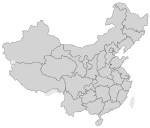Jiangxi
Jiangxi (![]()
Jiangxi Province 江西省 | |
|---|---|
Province | |
| Name transcription(s) | |
| • Chinese | 江西省 (Jiāngxī Shěng) |
| • Abbreviation | JX / 赣 (pinyin: Gàn; Gan Chinese: Kōm) |
| • Gan | Kongsi |
| • Hakka Pinyim | Gong1 Si1 Sen3 |
 | |
.svg.png) Map showing the location of Jiangxi Province | |
| Coordinates: 27°18′N 116°00′E | |
| Capital (and largest city) | Nanchang |
| Divisions | 11 prefectures, 99 counties, 1549 townships |
| Government | |
| • Secretary | Liu Qi |
| • Governor | Yi Lianhong |
| Area | |
| • Total | 166,919 km2 (64,448 sq mi) |
| Area rank | 18th |
| Highest elevation | 2,158 m (7,080 ft) |
| Population (2013)[1] | |
| • Total | 45,200,000 |
| • Rank | 13th |
| • Density | 270/km2 (700/sq mi) |
| • Density rank | 16th |
| Demographics | |
| • Ethnic composition | Han – 99.7% She – 0.2% |
| • Languages and dialects | Gan, Hakka, Huizhou, Wu, Jianghuai Mandarin |
| ISO 3166 code | CN-JX |
| GDP (2017 [2]) | CNY 2.08 trillion USD 308.34 billion (16th) |
| • per capita | CNY 45,187 USD 6,693 (20th) |
| HDI (2018) | 0.727[3] (high) (23rd) |
| Website | http://www.jiangxi.gov.cn/ (in Chinese) |
| Jiangxi | |||||||||||||||||||||||||||||||||||
|---|---|---|---|---|---|---|---|---|---|---|---|---|---|---|---|---|---|---|---|---|---|---|---|---|---|---|---|---|---|---|---|---|---|---|---|
"Jiangxi" in Chinese characters | |||||||||||||||||||||||||||||||||||
| Chinese | 江西 | ||||||||||||||||||||||||||||||||||
| Gan | Kong si | ||||||||||||||||||||||||||||||||||
| Postal | Kiangsi | ||||||||||||||||||||||||||||||||||
| Literal meaning | "Western Jiang[nan]" | ||||||||||||||||||||||||||||||||||
| |||||||||||||||||||||||||||||||||||
The name "Jiangxi" derives from the circuit administrated under the Tang dynasty in 733, Jiangnanxidao (江南西道; 'Circuit of Western Jiangnan'; Gan: Kongnomsitau).[6] The abbreviation for Jiangxi is "赣" (pinyin: Gàn; Gan: Gōm), for the Gan River which runs across from the south to the north and flows into the Yangtze River. Jiangxi is also alternately called Ganpo Dadi (贛鄱大地) which literally means the "Great Land of Gan and Po".
After the fall of the Qing dynasty, Jiangxi became one of the earliest bases for the Communists and many peasants were recruited to join the growing people's revolution. The Nanchang Uprising took place in Jiangxi on August 1, 1927, during the Chinese Civil War. Later the Communist leadership hid in the mountains of southern and western Jiangxi, hiding from the Kuomintang's attempts to eradicate them. In 1931, the Chinese Soviet Republic's government was established in Ruijin, which is sometimes called the "Former Red Capital" (红色故都, Gan: Fūng-set Kū-tu), or just the "Red Capital". In 1935, after complete encirclement by the Nationalist forces, the Communists broke through and began the Long March to Yan'an.
The southern half of Jiangxi is hilly and mountainous, with ranges and valleys interspersed; notable mountains and mountains ranges include Mount Lu, the Jinggang Mountains and Mount Sanqing. The northern half is comparatively lower in altitude. The Gan River flows through the province.
Although the majority of Jiangxi's population is Han Chinese, Jiangxi is linguistically diverse. It is considered the center of Gan Chinese; Hakka Chinese, a close variety of Gan, is also spoken to some degree. Jiangxi is rich in mineral resources, leading the provinces of China in deposits of copper, tungsten, gold, silver, uranium, thorium, tantalum, niobium.
History
Jiangxi is centered on the Gan River valley, which historically provided the main north-south transport route of south China. The corridor along the Gan River is one of the few easily traveled routes through the otherwise mountainous and rugged terrain of the south-eastern mountains. This open corridor was the primary route for trade and communication between the North China Plain and the Yangtze River valley in the north and the territory of modern Guangdong province in the south. As a result, Jiangxi has been strategically important throughout much of China's history.
Jiangxi was outside the sphere of influence of early Chinese civilization during the Shang dynasty (16th to 11th centuries BC). It is likely that peoples collectively known as the Baiyue inhabited the region. During the Spring and Autumn period, the northern part of modern Jiangxi formed the western frontier of the state of Wu. After Wu was conquered by the state of Yue (a power based in modern northern Zhejiang) in 473 BC, the state of Chu (based in modern Hubei) took over northern Jiangxi and there may have been some Yue influence in the south. Chu subjugated Yue in 333 BC. In 223 BC, when Qin conquered Chu, a majority of the Jiangxi area was recorded to be put under Jiujiang Commandary situated in Shouchun (壽春).[7] However the commandary was ineffective and ended shortly when Qin falls.
Yuzhang Commandery (豫章, Gan: Ì-zong) was established in Jiangxi at the beginning of the Han dynasty, possibly before the death of Xiang Yu in 202 BC, and it's also the very first commandery set up by Chinese dynasty in Jiangxi. It was named after the Yuzhang River (豫章江, Gan: Ì-zong Kong), the original name of Gan River. "Gan" has become the abbreviation of the province. In 201, eight counties were added to the original seven of Qin, and three more were established in later years. Throughout most of the Han dynasty the commandery's eighteen counties covered most of the modern province of Jiangxi. The county seats of Nanchang, Gan, Yudu, Luling among others were located at the sites of modern major cities. Other counties, however, have been moved or abolished in later centuries.
Under the reign of Emperor Wu of the Han dynasty, Yuzhang Commandery was assigned to Yangzhou Province, as part of a trend to establish provinces (zhou) all across China. In 291 AD, during the Western Jin dynasty, Jiangxi became its own Zhou called Jiangzhou (江州, Gan: Kong-chiu). During the Southern and Northern Dynasties, Jiangxi was under the control of the southern dynasties, and the number of zhou slowly grew.
During the Sui dynasty, there were seven commanderies and twenty-four counties in Jiangxi. During the Tang dynasty, another commandery and fourteen counties were added. Commanderies were then abolished, becoming zhou (henceforth translated as "prefectures" rather than "provinces").
Circuits were established during the Tang dynasty as a new top-level administrative division. At first Jiangxi was part of the Jiangnan Circuit (lit. "Circuit south of the Yangtze"). In 733, this circuit was divided into western and eastern halves. Jiangxi was found in the western half, which was called Jiangnanxi Circuit (lit. "Western circuits south of the Yangtze"). This is the source of the modern name "Jiangxi".
The Tang dynasty collapsed in 907, heralding the division of the Five Dynasties and Ten Kingdoms period. Jiangxi first belonged to Wu (吳, Gan: Ng), then to Southern Tang (南唐, Gan: Nām-thóng). Both states were based in modern-day Nanjing, further down the Yangtze River.
During the Song dynasty, Jiangnanxi Circuit was reestablished with nine prefectures and four army districts (with sixty-eight districts).
During the Yuan dynasty, the circuit was divided into thirteen different circuits, and Jiangxi Province was established for the first time. This province also included the majority of modern Guangdong. Jiangxi acquired (more or less) its modern borders during the Ming dynasty after Guangdong was separated out. There has been little change to the borders of Jiangxi since.
After the fall of the Qing dynasty, Jiangxi became one of the earliest bases for the Communists and many peasants were recruited to join the growing people's revolution. The Nanchang Uprising took place in Jiangxi on August 1, 1927, during the Chinese Civil War. Later the Communist leadership hid in the mountains of southern and western Jiangxi, hiding from the Kuomintang's attempts to eradicate them. In 1931, the Chinese Soviet Republic's government was established in Ruijin, which is sometimes called the "Former Red Capital" (红色故都, Gan: Fūng-set Kū-tu), or just the "Red Capital". In 1935, after complete encirclement by the Nationalist forces, the Communists broke through and began the Long March to Yan'an.
From 1930 to 1934, the National Government carried out five military campaigns against the Jiangxi Soviet area. Its brutal two-party battles and cleansing (including the internal cleansing of the Red Army and the cleaning of the post-war government) caused a large number of deaths or escapes, causing the population of Jiangxi to drop by 40%, until only 13.8 million people were left in 1936.
In 1936, after the opening of the Yuehan Railway in Hunan, Jiangxi lost its important position regarding north-south traffic. In 1937, the east-west Zhegan Railway was opened to traffic, which changed the original traffic patterns in Jiangxi to a large extent. The Jiujiang Port (九江港) began to decline in importance.
Following the Doolittle Raid during World War II, most of the B-25 American crews that came down in China eventually made it to safety with the help of Chinese civilians and soldiers. The Chinese people who helped them, however, paid dearly for sheltering the Americans. The Imperial Japanese Army began the Zhejiang-Jiangxi Campaign to intimidate the Chinese from helping downed American airmen. The Japanese killed an estimated 250,000 civilians while searching for Doolittle’s men.[8]
Geography
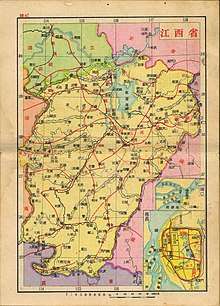



Mountains surround Jiangxi on three sides, with the Mufu Mountains, Jiuling Mountains, and Luoxiao Mountains on the west; Huaiyu Mountains and Wuyi Mountains on the east; and the Jiulian Mountains (九连山) and Dayu Mountains in the south. The southern half of the province is hilly with ranges and valleys interspersed; while the northern half is flatter and lower in altitude. The highest point in Jiangxi is Mount Huanggang (黄岗山) in the Wuyi Mountains, on the border with Fujian. It has an altitude of 2,157 metres (7,077 ft).
The Gan River dominates the province, flowing through the entire length of the province from south to north. It enters Lake Poyang in the north, the largest freshwater lake of China; that lake in turn empties into the Yangtze River, which forms part of the northern border of Jiangxi. Important reservoirs include the Xiushui Tuolin Reservoir in the northwest of the province on the Xiushui River, and the Wan'an Reservoir(zh) in the upper section of the Gan.
Jiangxi has a humid subtropical climate (Cfa under the Köppen climate classification), with short, cool, damp winters, and very hot, humid summers. Average temperatures are about 3 to 9 °C (37 to 48 °F) in January and 27 to 30 °C (81 to 86 °F) in July. Annual precipitation is 1,200 to 1,900 millimetres (47 to 75 in), much of it falling in the heavy rains occurring in late spring and summer.
Nanchang, the provincial capital and the most densely populated city, is one of the largest Chinese metropolises. Nanchang is the hub of Jiangxi civilization throughout its history, which plays a leading role in the commercial, intellectual and industrial and political fields.[9] Ganzhou is the largest subdivision of Jiangxi.
Major cities in Jiangxi include:
Administrative divisions
Jiangxi is divided into eleven prefecture-level divisions: all prefecture-level cities:
| Administrative divisions of Jiangxi | ||||||||
|---|---|---|---|---|---|---|---|---|
| Division code[10] | Division | Area in km2[11] | Population 2010[12] | Seat | Divisions[13] | |||
| Districts | Counties | CL cities | ||||||
| 360000 | Jiangxi Province | 166900.00 | 44,567,475 | Nanchang city | 26 | 62 | 12 | |
| 360100 | Nanchang city | 7432.18 | 5,042,565 | Donghu District | 6 | 3 | ||
| 360200 | Jingdezhen city | 5256.23 | 1,587,477 | Changjiang District | 2 | 1 | 1 | |
| 360300 | Pingxiang city | 3823.99 | 1,854,510 | Anyuan District | 2 | 3 | ||
| 360400 | Jiujiang city | 18796.79 | 4,728,763 | Xunyang District | 3 | 7 | 3 | |
| 360500 | Xinyu city | 3177.68 | 1,138,873 | Yushui District | 1 | 1 | ||
| 360600 | Yingtan city | 3556.74 | 1,124,906 | Yuehu District | 2 | 1 | ||
| 360700 | Ganzhou city | 39317.14 | 8,368,440 | Zhanggong District | 3 | 13 | 2 | |
| 360800 | Ji'an city | 25283.80 | 4,810,340 | Jizhou District | 2 | 10 | 1 | |
| 360900 | Yichun city | 18637.67 | 5,419,575 | Yuanzhou District | 1 | 6 | 3 | |
| 361000 | Fuzhou city | 18811.12 | 3,912,312 | Linchuan District | 2 | 9 | ||
| 361100 | Shangrao city | 22826.04 | 6,579,714 | Xinzhou District | 3 | 8 | 1 | |
| Administrative divisions in Chinese and varieties of romanizations | ||||
|---|---|---|---|---|
| English | Chinese | Pinyin | Gan Romanization | |
| Jiangxi Province | 江西省 | Jiāngxī Shěng | kɔŋ11 śi11 sɛn2 | |
| Nanchang city | 南昌市 | Nánchāng Shì | lan31 chɔŋ11 si32 | |
| Jingdezhen city | 景德镇市 | Jǐngdézhèn Shì | ćin2 tɛt41 cǝn31 si32 | |
| Pingxiang city | 萍乡市 | Píngxiāng Shì | phin12 śiɔŋ11 si32 | |
| Jiujiang city | 九江市 | Jiǔjiāng Shì | ćiu2 kɔŋ11 si32 | |
| Xinyu city | 新余市 | Xīnyú Shì | śin11 y31 si32 | |
| Yingtan city | 鹰潭市 | Yīngtán Shì | in11 ? si32 | |
| Ganzhou city | 赣州市 | Gànzhōu Shì | ? cǝu11 si32 | |
| Ji'an city | 吉安市 | Jí'ān Shì | ćit41 ŋɔn11 si32 | |
| Yichun city | 宜春市 | Yíchūn Shì | ńi31 chun11 si32 | |
| Fuzhou city | 抚州市 | Fǔzhōu Shì | ? cǝu11 si32 | |
| Shangrao city | 上饶市 | Shàngráo Shì | sɔŋ32 ? si32 | |
These prefecture-level cities are in turn subdivided into 100 county-level divisions (23 districts, 11 county-level cities, and 66 counties). Those in turn are divided into 1548 township-level divisions (770 towns, 651 townships, seven ethnic townships, and 120 subdistricts).
See List of administrative divisions of Jiangxi for a complete list of county-level divisions.
Urban areas
| Population by urban areas of prefecture & county cities | |||||
|---|---|---|---|---|---|
| # | City | Urban area[14] | District area[14] | City proper[14] | Census date |
| 1 | Nanchang[lower-alpha 1] | 2,223,661 | 2,357,839 | 5,042,566 | 2010-11-01 |
| (1) | Nanchang (new district)[lower-alpha 1] | 390,719 | 795,412 | see Nanchang | 2010-11-01 |
| 2 | Pingxiang | 716,229 | 893,550 | 1,854,515 | 2010-11-01 |
| 3 | Jiujiang[lower-alpha 2] | 611,321 | 704,986 | 4,728,778 | 2010-11-01 |
| (3) | Jiujiang (new district)[lower-alpha 2] | 93,035 | 159,909 | see Jiujiang | 2010-11-01 |
| 4 | Ganzhou[lower-alpha 3] | 605,231 | 642,653 | 8,368,447 | 2010-11-01 |
| (4) | Ganzhou (new districts)[lower-alpha 3] | 430,680 | 1,334,600 | see Ganzhou | 2010-11-01 |
| 5 | Xinyu | 567,820 | 839,488 | 1,138,874 | 2010-11-01 |
| 6 | Fuzhou[lower-alpha 4] | 482,940 | 1,089,888 | 3,912,307 | 2010-11-01 |
| (6) | Fuzhou (new district)[lower-alpha 4] | 169,404 | 438,319 | see Fuzhou | 2010-11-01 |
| 7 | Yichun | 461,817 | 1,045,952 | 5,419,591 | 2010-11-01 |
| 8 | Jingdezhen | 430,084 | 473,561 | 1,587,477 | 2010-11-01 |
| 9 | Fengcheng | 379,914 | 1,336,392 | see Yichun | 2010-11-01 |
| 10 | Ji'an | 328,318 | 538,699 | 4,810,339 | 2010-11-01 |
| 11 | Shangrao[lower-alpha 5] | 298,975 | 416,219 | 6,579,747 | 2010-11-01 |
| (11) | Shangrao (new district)[lower-alpha 5] | 392,302 | 752,953 | see Shangrao | 2010-11-01 |
| 12 | Gao'an | 295,507 | 811,633 | see Yichun | 2010-11-01 |
| 13 | Leping | 286,351 | 810,353 | see Jingdezhen | 2010-11-01 |
| 14 | Ruijin | 216,229 | 618,885 | see Ganzhou | 2010-11-01 |
| 15 | Guixi | 210,319 | 558,451 | see Yingtan | 2010-11-01 |
| 16 | Yingtan[lower-alpha 6] | 191,893 | 214,229 | 1,125,156 | 2010-11-01 |
| (16) | Yingtan (new district)[lower-alpha 6] | 131,470 | 352,476 | see Yingtan | 2010-11-01 |
| 17 | Zhangshu | 188,586 | 555,120 | see Yichun | 2010-11-01 |
| 18 | Ruichang | 150,531 | 419,047 | see Jiujiang | 2010-11-01 |
| 19 | Dexing | 148,565 | 293,201 | see Shangrao | 2010-11-01 |
| (20) | Gongqingcheng[lower-alpha 7] | 118,986 | 118,986 | see Jiujiang | 2010-11-01 |
| (21) | Lushan[lower-alpha 8] | 101,630 | 245,526 | see Jiujiang | 2010-11-01 |
| 22 | Jinggangshan | 86,673 | 152,310 | see Ji'an | 2010-11-01 |
- New district established after census: Xinjian (Xinjian County). The new district not included in the urban area & district area count of the pre-expanded city.
- New district established after census: Chaisang (Jiujiang County). The new district not included in the urban area & district area count of the pre-expanded city.
- New districts established after census: Nankang (Nankang CLC), Ganxian (Ganxian County). These new districts not included in the urban area & district area count of the pre-expanded city.
- New district established after census: Dongxiang (Dongxiang County). The new district not included in the urban area & district area count of the pre-expanded city.
- New district established after census: Guangfeng (Guangfeng County). The new district not included in the urban area & district area count of the pre-expanded city.
- New district established after census: Yujiang (Yujiang County). The new district not included in the urban area & district area count of the pre-expanded city.
- Gongqingcheng CLC was established by splitting from parts of De'an County after census.
- Xingzi County is currently known as Lushan CLC after census.
Politics
The Politics of Jiangxi is structured in a dual party-government system like all other governing institutions in mainland China.
The Governor of Jiangxi is the highest-ranking official in the People's Government of Jiangxi. However, in the province's dual party-government governing system, the Governor has less power than the Jiangxi Communist Party of China Provincial Committee Secretary, colloquially termed the "Jiangxi CPC Party Chief".
Economy
Rice is the dominant crop in Jiangxi. Cash crops commonly grown include cotton and rapeseed. Jiangxi is the leading producer of kumquats in China, particularly Suichuan County.[15]
Jiangxi is rich in mineral resources, leading the provinces of China in deposits of copper, tungsten, gold, silver, uranium, thorium, tantalum, niobium, among others. Noted centers of mining include Dexing (copper) and Dayu County (tungsten).
It is located in extreme proximity to some of the richest provinces of China (Guangdong, Zhejiang, Fujian), which are sometimes blamed for taking away talent and capital from Jiangxi.[16]
Jiangxi has the lowest wages and third lowest property prices in all of China.,[16] As of 2016 Jiangxi's nominal GDP was CNY 1.84 trillion or USD 276.48 billion, and a per capita of CNY 40,400 or USD 6,082.[17]
| Historical GDP of Jiangxi Province for 1978 –present (SNA2008)[17] (purchasing power parity of Chinese Yuan, as Int'l. dollar based on IMF WEO October 2017[18]) | |||||||||
| year | GDP | GDP per capita (GDPpc) based on mid-year population |
Reference index | ||||||
| GDP in millions | real growth (%) |
GDPpc | exchange rate 1 foreign currency to CNY | ||||||
| CNY | USD | PPP (Int'l$.) |
CNY | USD | PPP (Int'l$.) |
USD 1 | Int'l$. 1 (PPP) | ||
| 2016 | 1,836,440 | 276,477 | 524,562 | 9.0 | 40,400 | 6082 | 11,540 | 6.6423 | 3.5009 |
| 2015 | 1,672,378 | 268,508 | 471,159 | 9.1 | 36,968 | 5935 | 10,415 | 6.2284 | 3.5495 |
| 2014 | 1,571,463 | 255,822 | 442,616 | 9.7 | 34,890 | 5680 | 9,827 | 6.1428 | 3.5504 |
| 2013 | 1,441,019 | 232,678 | 402,868 | 10.1 | 32,122 | 5187 | 8,980 | 6.1932 | 3.5769 |
| 2012 | 1,294,888 | 205,131 | 364,675 | 11.0 | 28,967 | 4589 | 8,158 | 6.3125 | 3.5508 |
| 2011 | 1,170,282 | 181,192 | 333,842 | 12.4 | 26,292 | 4071 | 7,500 | 6.4588 | 3.5055 |
| 2010 | 945,126 | 139,615 | 285,485 | 14.0 | 21,368 | 3156 | 6,454 | 6.7695 | 3.3106 |
| 2009 | 765,518 | 112,065 | 242,444 | 13.2 | 17,437 | 2553 | 5,522 | 6.8310 | 3.1575 |
| 2008 | 697,105 | 100,374 | 219,436 | 13.3 | 15,986 | 2302 | 5,032 | 6.9451 | 3.1768 |
| 2007 | 580,025 | 76,279 | 192,386 | 13.2 | 13,389 | 1761 | 4,441 | 7.6040 | 3.0149 |
| 2006 | 482,053 | 60,470 | 167,513 | 12.3 | 11,197 | 1405 | 3,891 | 7.9718 | 2.8777 |
| 2005 | 405,676 | 49,523 | 141,894 | 12.9 | 9,478 | 1157 | 3,315 | 8.1917 | 2.8590 |
| 2000 | 200,307 | 24,196 | 73,661 | 8.0 | 4851 | 586 | 1,784 | 8.2784 | 2.7193 |
| 1995 | 116,973 | 14,007 | 42,857 | 6.8 | 2896 | 347 | 1,061 | 8.3510 | 2.7294 |
| 1990 | 42,862 | 8,961 | 25,174 | 4.5 | 1134 | 237 | 666 | 4.7832 | 1.7026 |
| 1985 | 20,789 | 7,079 | 14,831 | 14.8 | 597 | 203 | 426 | 2.9366 | 1.4017 |
| 1980 | 11,115 | 7,418 | 7,432 | 4.2 | 342 | 228 | 229 | 1.4984 | 1.4955 |
| 1978 | 8,700 | 5,595 | 13.3 | 276 | 177 | 1.5550 | |||
Economic and technological development zones
- Nanchang Export Processing Zone
Nanchang National Export Expressing Zone is located in NanChang Hi-Tech Industrial Development Zone, it was approved by the State Council on May 8, 2006, and passed the national acceptance inspection on Sep 7th, 2007. It has a planning area of 1 km2 (0.39 sq mi) and now has built 0.31 km2 (0.12 sq mi). It enjoys simple and convenient customs clearances, and special preferential policies both for Nanchang National Export Expressing Zone and NCHDZ.[19]
- Nanchang National High-tech Industrial Development Zone
Nanchang National High-tech Industrial Development Zone (NCHDZ for short hereafter) is the only national grade high-tech zoned in Jiangxi, it was established in Mar. 1991. The zone covers an area of 231 km2 (89 sq mi), in which 32 km2 (12 sq mi) have been completed. NCHDZ possesses unique nature condition and sound industry foundation of accepting electronics industry. NCHDZ has brought 25% industrial added value and 50% industrial benefit and tax to Nanchang city by using only 0.4% land area.[20]
- Nanchang Economic and Technological Development Zone[21]
Demographics
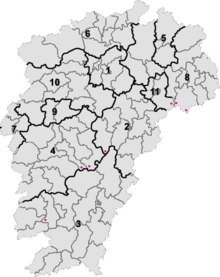
The population of Jiangxi is approximately 39.66 million.[22] 99.73% of that is Han Chinese, predominantly Gan and Hakka. Ganzhou, Jiangxi's largest city, has an especially large number of Hakka. Ethnic minorities include She.
Jiangxi and Henan both have the most unbalanced gender ratios of all Chinese provinces. Based on a 2009 British Medical Journal study, the ratio is over 140 boys for every 100 girls in the 1-4 age group.[23]
|
|
In 2019 the most-common surname in Jiangxi was Liú (刘), the only province where this was the case. Overall Liu is the fourth-most common surname in the country.[34]
Religion
The predominant religions in Jiangxi are Chinese folk religions, Taoist traditions and Chinese Buddhism. According to surveys conducted in 2007 and 2009, 24.05% of the population believes and is involved in ancestor veneration, while 2.31% of the population identifies as Christian.[35]
The reports didn't give figures for other types of religion; 73.64% of the population may be either irreligious or involved in worship of nature deities, Buddhism, Confucianism, Taoism, folk religious sects.
|
Culture
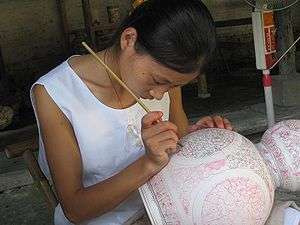
Jiangxi is the main area of concentration of the Gan varieties of Chinese, spoken over most of the northern two-thirds of the province. Examples include the Nanchang dialect, Yichun dialect and Ji'an dialect. The southern one-third of the province speaks Hakka. There are also Mandarin, Huizhou, and Wu dialects spoken along the northern border.
Ganju (Jiangxi opera) is the type of Chinese opera performed in Jiangxi.
Although little known outside of the province, Jiangxi cuisine is rich and distinctive. Flavors are some of the strongest in China, with heavy use of chili peppers and especially pickled and fermented products.
Jingdezhen is widely regarded as the producer of the best porcelain in China.[36]
Jiangxi also was a historical center of Chan Buddhism.
Prominent examples of Hakka architecture can be found in Jiangxi.
Transportation
As of January 2015, Jiangxi had two Yangtze River crossings, both in Jiujiang.
Rail
The Beijing–Kowloon Railway and Shanghai–Kunming Railway crisscross the province and intersect at Nanchang, which also has a high-speed rail link to Jiujiang. In addition, Jiangxi is connected by rail to Anhui Province via the Anhui–Jiangxi and Tongling–Jiujiang Railways; to Hubei via the Wuhan–Jiujiang Railway; and to Fujian via the Yingtan–Xiamen, Hengfeng–Nanping, Ganzhou–Longyan and Xiangtang–Putian Railways.
Tourism
There are several famous mountains in Jiangxi Province, including Mount Lu in Jiujiang city, Mount jinggang at the boarder of jiangxi province and Hunan province, Mount Sanqing in Yushan county.
Near the northern port city of Jiujiang lies the well-known resort area of Mount Lu. Also near the city is the Donglin (East Wood) Temple , one important Buddhist temple in china.
Near the small city of Yingtan is the resort area of Longhushan, which purports to be the birthplace of Taoism and hence has great symbolic value to Taoists. The region has many temples, cave complexes, mountains and villages.
The Lushan National Park has been a UNESCO World Heritage Site since 1996.
In 2007, Jiangxi (specifically the Zhelin Reservoir, about 40 kilometres (25 mi) from Nanchang) was the filming location for the fifteenth series of the American TV show Survivor.
Flora and fauna
The mountainous terrain and large forest coverage of Jiangxi has made it historically one of the more wild places of central China. South China tigers have been seen as recently as fifteen or twenty years ago and projects are underway to document evidence of existing tigers, if there are any. Several mountain areas along the northern border with Hunan and Hubei are potential sites for "wilderness" preserves specifically for protecting or even reintroducing tigers.
Other wildlife, though not plentiful, are more numerous in Jiangxi than in many other developed areas of China. Numerous species of birds are common, especially around the marshes of Lake Poyang in the north. Though protected, mammals such as muntjac, wild boar, civet cats, and pangolins, are still common enough that they'll even occasionally be seen in markets for sale as game meat, or possibly even in a forest.
The late Paleocene mesonychid, Jiangxia chaotoensis was found in the province, and named after it.
Education
Colleges and universities
- Jiangxi College Of Foreign Studies
- East China Institute of Technology
- East China Jiaotong University
- Jiangxi Agricultural University
- Jiangxi Institute of Education
- Jiangxi Normal University
- Jiangxi Science and Technology Normal University
- Jiangxi University of Finance and Economics
- Jingdezhen Ceramic Institute
- Jinggangshan University
- Jiujiang Financial and Economic College
- Jiujiang Medical College
- Jiujiang Teachers College
- Nanchang Institute of Technology
- Nanchang Hangkong University
- Nanchang University
- Yichun University
Sister Provinces






See also
- Major national historical and cultural sites in Jiangxi
Notes
- The data was collected by the Chinese General Social Survey (CGSS) of 2009 and by the Chinese Spiritual Life Survey (CSLS) of 2007, reported and assembled by Xiuhua Wang (2015)[35] in order to confront the proportion of people identifying with two similar social structures: ① Christian churches, and ② the traditional Chinese religion of the lineage (i. e. people believing and worshipping ancestral deities often organised into lineage "churches" and ancestral shrines). Data for other religions with a significant presence in China (deity cults, Buddhism, Taoism, folk religious sects, Islam, et. al.) was not reported by Wang.
- This may include:
- Buddhists;
- Confucians;
- Deity worshippers;
- Taoists;
- Members of folk religious sects;
- Small minorities of Muslims;
- And people not bounded to, nor practicing any, institutional or diffuse religion.
References
- "Communiqué of the National Bureau of Statistics of People's Republic of China on Major Figures of the 2010 Population Census [1] (No. 2)". National Bureau of Statistics of China. 29 April 2011. Archived from the original on 27 July 2013. Retrieved 4 August 2013.
- 江西省2017年国民经济和社会发展统计公报 (in Chinese). Statistical Bureau of Jiangxi. 2018-03-09. Retrieved 2018-06-22.
- "Sub-national HDI - Subnational HDI - Global Data Lab". globaldatalab.org. Retrieved 2020-04-17.
- "Encyclopaedia Britannica". Retrieved 19 September 2017.
- "www.ctoptravel.com". www.ctoptravel.com. Archived from the original on 2012-08-16. Retrieved 2012-12-24.
- (in Chinese) Origin of the Names of China's Provinces, People's Daily Online.
- http://218.65.88.149:8080/was40/detail?record=1&primarykeyvalue=%E9%A2%98%E5%90%8D%3D%E8%B1%AB%E7%AB%A0%E6%95%85%E9%83%A1&channelid=7274%5B%5D
- PBS Perilous Flight
- "www.china.com.cn". China.com.cn. 2008-11-26. Retrieved 2012-12-24.
- 中华人民共和国县以上行政区划代码 (in Chinese). Ministry of Civil Affairs.
- Shenzhen Bureau of Statistics. Archived copy 《深圳统计年鉴2014》 (in Chinese). China Statistics Print. Archived from the original on 2015-05-12. Retrieved 2015-05-29.CS1 maint: archived copy as title (link)
- Census Office of the State Council of the People's Republic of China; Population and Employment Statistics Division of the National Bureau of Statistics of the People's Republic of China (2012). 中国2010人口普查分乡、镇、街道资料 (1 ed.). Beijing: China Statistics Print. ISBN 978-7-5037-6660-2.
- Ministry of Civil Affairs (August 2014). 《中国民政统计年鉴2014》 (in Chinese). China Statistics Print. ISBN 978-7-5037-7130-9.
- 中国2010年人口普查分县资料. Compiled by 国务院人口普查办公室 [Department of Population Census of the State Council], 国家统计局人口和社会科技统计司编 [Department of Population and Social Science and Statistics, National Bureau of Statistics]. Beijing: China Statistics Print. 2012. ISBN 978-7-5037-6659-6.CS1 maint: others (link)
- Zhonghua quan guo min zhu fu nü lian he hui (1988). Chung-kuo fu nü. Foreign Language Press. Retrieved 16 June 2011.
- "Jiangxi Province: Economic News and Statistics for Jiangxi's Economy". Thechinaperspective.com. Archived from the original on 2012-08-15. Retrieved 2012-12-24.
- Historical GDP of Jiangxi Province published on Jiangxi Statistical Yearbook 2017, ALSO see Jiangxi'GDP Revison (Chinese)
- Purchasing power parity (PPP) for Chinese yuan is estimate according to IMF WEO (October 2017) data; Exchange rate of CN¥ to US$ is according to State Administration of Foreign Exchange, published on China Statistical Yearbook.
- "Nanchang Export Processing Zone". RightSite.asia. Retrieved 2012-12-24.
- "Nanchang High-Tech Industrial Development Zone". RightSite.asia. Retrieved 2012-12-24.
- "Nanchang Economic & Technological Development Zone". RightSite.asia. Retrieved 2012-12-24.
- ":: Xinhuanet". News.xinhuanet.com. 2003-04-02. Archived from the original on 2013-11-15. Retrieved 2012-12-24.
- "China's excess males, sex selective abortion, and one child policy: analysis of data from 2005 national intercensus survey". BMJ. Retrieved 2012-12-24.
- 1912年中国人口. Retrieved 6 March 2014.
- 1928年中国人口. Retrieved 6 March 2014.
- 1936-37年中国人口. Retrieved 6 March 2014.
- 1947年全国人口. Retrieved 6 March 2014.
- 中华人民共和国国家统计局关于第一次全国人口调查登记结果的公报. National Bureau of Statistics of China. Archived from the original on 2009-08-05.
- 第二次全国人口普查结果的几项主要统计数字. National Bureau of Statistics of China. Archived from the original on 2012-09-14.
- 中华人民共和国国家统计局关于一九八二年人口普查主要数字的公报. National Bureau of Statistics of China. Archived from the original on 2012-05-10.
- 中华人民共和国国家统计局关于一九九〇年人口普查主要数据的公报. National Bureau of Statistics of China. Archived from the original on 2012-06-19.
- 现将2000年第五次全国人口普查快速汇总的人口地区分布数据公布如下. National Bureau of Statistics of China. Archived from the original on 2012-08-29.
- "Communiqué of the National Bureau of Statistics of People's Republic of China on Major Figures of the 2010 Population Census". National Bureau of Statistics of China. Archived from the original on 2013-07-27.
- http://www.bjnews.com.cn/news/2020/01/20/676822.html
- China General Social Survey 2009, Chinese Spiritual Life Survey (CSLS) 2007. Report by: Xiuhua Wang (2015, p. 15) Archived 2015-09-25 at the Wayback Machine
- "Jingdezhen: Where Emperors Got Their Porcelain - Caixin Global". www.caixinglobal.com. Retrieved 2018-08-28.
- ":: Notícias MS". Noticias.ms.gov.br. 2009-10-23. Archived from the original on 2012-02-28. Retrieved 2012-12-24.
- Muguntan Vanar (21 April 2019). "Sabah and China's Jiangxi look to become 'sister provinces', says Shafie". The Star. Retrieved 20 May 2019.
- "Sabah, Jiangxi sign friendship pact". The Borneo Post. 22 April 2019. Retrieved 20 May 2019.
External links
| Wikimedia Commons has media related to Jiangxi. |
| Wikisource has the text of the 1911 Encyclopædia Britannica article Kiang-Si. |

- (in Chinese) Jiangxi Government website
- "Map of Jiangxi Province with Explanations" from 1573 CE - 1620 CE
- Economic profile for Jiangxi at HKTDC

